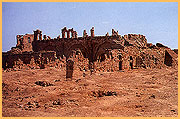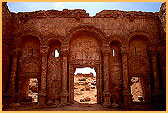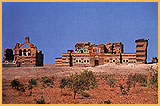|
Fortresses towns and garrisons of
the eastern frontier: Zenobia, Sergiopolis, Qasr ibn-Wardan
The Early Byzantine period saw the reintroduction
in the Mediterranean o f
the walled city. Walls contributed to the recovery of urban
life from the third-century crisis, and to the struggle to
survive further threats. The fortifications of the cities
on the eastern frontier were thus a focus for Justinian's
construction activity. Zenobia-Halabiye, on the Euphrates,
was enlarged and fortified by two of Justinian's mechanikoi
(architects having a ground in mathematics), John of Constantinople
and Isidore the Younger. The latter was the nephew of Isidore
of Tralles, the architect of St Sophia, and was also appointed
to supervise the reconstruction of St Sophia after its original
dome collapsed in 558. Zenobia's massive walls rise steeply
to an unassailable citadel; they comprise a three-storey guardhouse
(praetorium) and are protected from the rising waters of the
Euphrates by a breakwater. f
the walled city. Walls contributed to the recovery of urban
life from the third-century crisis, and to the struggle to
survive further threats. The fortifications of the cities
on the eastern frontier were thus a focus for Justinian's
construction activity. Zenobia-Halabiye, on the Euphrates,
was enlarged and fortified by two of Justinian's mechanikoi
(architects having a ground in mathematics), John of Constantinople
and Isidore the Younger. The latter was the nephew of Isidore
of Tralles, the architect of St Sophia, and was also appointed
to supervise the reconstruction of St Sophia after its original
dome collapsed in 558. Zenobia's massive walls rise steeply
to an unassailable citadel; they comprise a three-storey guardhouse
(praetorium) and are protected from the rising waters of the
Euphrates by a breakwater.
In 527-542, the emperor gave huge fortified walls,
as well as colonnaded streets, cisterns, baths and churches,
to the remote pilgrimage c entre
of Resafa-Sergiopolis (named after the venerated saint, Sergius).
The walls enclose an area of roughly 540 by 380 m and are
equipped with square, polygonal and round towers nearly 12
m high. Of the four gates of the city, the one facing the
pacified parts of the empire to the north was decorated with
half columns and blind arcades, all richly decorated. An elongated
tetraconch and
Basilica B, now identified as the shrine of Sts Sergius and
Bacchus, were probably erected as part of the imperial building
program. The former lies close to the north gate, and was
the first to be approached by incoming visitors as they proceeded
along the colonnaded street towards the southern sector. entre
of Resafa-Sergiopolis (named after the venerated saint, Sergius).
The walls enclose an area of roughly 540 by 380 m and are
equipped with square, polygonal and round towers nearly 12
m high. Of the four gates of the city, the one facing the
pacified parts of the empire to the north was decorated with
half columns and blind arcades, all richly decorated. An elongated
tetraconch and
Basilica B, now identified as the shrine of Sts Sergius and
Bacchus, were probably erected as part of the imperial building
program. The former lies close to the north gate, and was
the first to be approached by incoming visitors as they proceeded
along the colonnaded street towards the southern sector.
Basilica B has an apsed sanctuary flanked to the north
by a triconch martyrial chapel. The triconch was lavishly
decorated with floors of  opus sectile,painted carved ornament and gold mosaic. A
reliquary sarcophagus
stood in the eastern conch. A square chamber was added later
next to the triconch in order to house a second sarcophagus,
which was provided with a rectangular cavity into which the
pilgrims poured libations. The two reliquaries may have commemorated
the local saints Sergius and Bacchus. Justinian and Theodora
are known to have presented the shrine with a gemmed cross,
which was seized in 540 by the Sassanid king Chosroes I, together
with the gold revetment of the saint's tomb and other treasures.
In 591-592, as a thanksgiving to St Sergius for a military
victory and the birth of a son, Chosroes II returned Justinian's
cross and gave the shrine several gold votive objects. A second
basilica (Basilica
A), identified by an inscription as the Church of the Holy
Cross, was built in 559 by bishop Abraham. It was linked to
a large ecclesiastical establishment, monastery, or pilgrim's
hostel, and displays the typical Syrian
bema in the
middle of the
nave.
opus sectile,painted carved ornament and gold mosaic. A
reliquary sarcophagus
stood in the eastern conch. A square chamber was added later
next to the triconch in order to house a second sarcophagus,
which was provided with a rectangular cavity into which the
pilgrims poured libations. The two reliquaries may have commemorated
the local saints Sergius and Bacchus. Justinian and Theodora
are known to have presented the shrine with a gemmed cross,
which was seized in 540 by the Sassanid king Chosroes I, together
with the gold revetment of the saint's tomb and other treasures.
In 591-592, as a thanksgiving to St Sergius for a military
victory and the birth of a son, Chosroes II returned Justinian's
cross and gave the shrine several gold votive objects. A second
basilica (Basilica
A), identified by an inscription as the Church of the Holy
Cross, was built in 559 by bishop Abraham. It was linked to
a large ecclesiastical establishment, monastery, or pilgrim's
hostel, and displays the typical Syrian
bema in the
middle of the
nave.
The importation of Justinianic architecture in Syria
is best illustrated by the military outpost of Qasr ibn-Wardan
(561-564), and its use of brick and domed structures. The
complex, which was probably the residence of a military commander,
comprises a palace, a church and a barracks building. Brick,
a material typically associated with the Aegean coastlands
and Italy, was used throughout, alternating with bands of
local basalt (brick was also used for the cisterns of Resafa,
and the walls of Zenobia). Domes, a clearly Constantinopolitan
feature, covered the palace audience hall and the church.
|